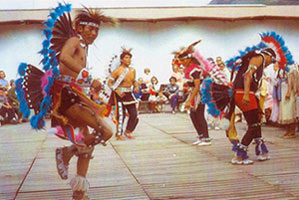 The oldest residents of Colorado, The Ute people, are Native Americans who roamed the mountains and vast areas of not only Colorado but also Utah, Wyoming, Eastern Nevada, Northern New Mexico and Arizona. Today, the Southern Utes that inhabited Colorado have broken up into units called bands. The Caputa band and the Mouache band comprise the Southern Ute tribe. Since 1895, members of these bands have resided on the Southern Ute Reservation in southwestern corner of Colorado, mostly along the border of New Mexico with headquarters in Ignacio, Colorado.
The oldest residents of Colorado, The Ute people, are Native Americans who roamed the mountains and vast areas of not only Colorado but also Utah, Wyoming, Eastern Nevada, Northern New Mexico and Arizona. Today, the Southern Utes that inhabited Colorado have broken up into units called bands. The Caputa band and the Mouache band comprise the Southern Ute tribe. Since 1895, members of these bands have resided on the Southern Ute Reservation in southwestern corner of Colorado, mostly along the border of New Mexico with headquarters in Ignacio, Colorado.
The Utes are proud people, handing down tribal history from generation to generation. Before the convenience of horses, Utes lived off the land, with a unique and strong relationship with the environment. By traveling to familiar places, they established well-traveled routes such as the Ute trail, which can still be explored. In all their travels, the Utes heavily relied on the natural resources directly around them for survival. They hunted and gathered plants to make the food, tools, and medicines they needed, intertwining tribal traditions and connections to the natural world in order to survive.
However, when winter came around, the Utes became limited in their endeavors. They spent winter evenings around the fire to socialize and share stories, along with conducting social and religious events. Time was also spent repairing tools and weapons, as well as making new garments. Winter was supposed to be a time of rest and rejuvenation, and to reinforce tribal customs.
With the first crackling of thunder in spring time, the Ute people knew it was time to dance the Bear Dance. The various bands of the Utes would gather, usually around mid-March, setting up camp and preparing for the exciting events ahead. Men handled most of the preparation, setting up the Bear Dance corral and preparing ceremonial artifacts. The women prepared the ceremonial clothing, which was usually vibrant and ornate. The storyteller would bring everyone together, telling tales about every aspect of life. The annual celebration allowed bands and relatives to socialize, and provided the younger generations an opportunity for the young members to meet and negotiate possible marriages.
By participating in the Bear Dance, the Ute people would release their tensions from a long quiet winter. Men and women wore various feathered plumes, which would then be left on a cedar tree at the east of the corral on the fourth and final day of the celebration. For the Utes, leaving the plume meant they could leave their troubles behind and start life anew.
The original story of the Bear Dance has been clouded out over time, but modern versions tell a story involving two Ute brothers and a bear. The two brothers were out hunting in the mountains and became tired, so they laid down to rest. One brother then noticed a bear, some distance away that was standing upright facing a tree and clawing it while the bear appeared to be dancing and making noise. The brother observed the bear very closely. The bear then taught the young hunter to do the song and dance. The bear told the young hunter that he must return to his people and teach them the songs and dance of the bear.
The Bear Dance celebrates the awakening of bears from their winter sleep and is done to welcome the spring. The dance is an age old tradition to celebrate spring that is still observed by Ute bands today. They sing songs that show respect for the spirit of the bear and that respect makes a person strong.
Today, the Bear Dance performed by the Utes takes place in the spring. Utes of all shapes and sizes gather for this social and rejuvenating gathering. They celebrate with a festival held in Southwest Colorado on the Ute Reservation. The Living Earth Festival allows the Utes to dance and sing together, a strong sense of pride resounding from within. The 2015 Ute Bear Dance will take place from May 22-23, 2015 and the public is welcome.
The time of Ute dominance in our landscape has passed, but we can learn much from their history and culture. We may not all participate in the rituals of the Bear Dance, but we can take time to honor and appreciate the coming spring and all that it entails, enriching our own lives through the process.
Celeste Drago is a Naturalist at Walking Mountains Science Center in Avon. Walking Mountains is open Monday through Saturday from 9 to 5 and it’s free to visit!









